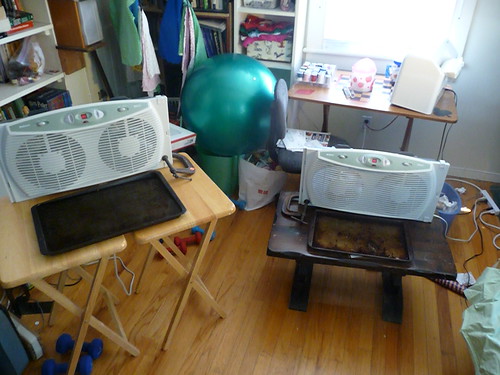
WARNING: SCIENCE CONTENT BELOW
How much you can cool a room using this method is dependent on the relative humidity on that particular day. The less relative humidity, the more water you can cool the room down. I found a quick and dirty formula for calculating the "Wet Bulb" temperature, which is the lowest possible temperature you can attain by evaporation alone given the current atmospheric conditions. It turns out that today's wet bulb temperature is 84 degrees, which will feel around 80 for me with the fans going - a bit hot, but definitely tolerable. The thermostats on the fans are holding at 85 right now. However, we haven't reached the hottest part of the day yet - I'll update later this afternoon to see how the experiment worked out.

How would humidity effect the wet-bulb factor? Say for example, 87 degrees F, 70% humidity and a dew point of 77?
ReplyDeletethe dew point is related to the humidity, so that is already taken into account.
ReplyDeleteFacinating ! Found this article through LifeHacker's e-mail newsletter. The "formula" for wet bulb seems related to cold weather: how to do you use that formula to calculate potential cooling in a high-humidity environment (like in the tropics) ?
ReplyDeletethanks, Bill
I'm going to try this in humid Hawaii.
ReplyDeleteHow or will this technique work with the fan placed in an open window?
ReplyDeleteI wonder if this would work better with a bunch of sponges in the tray. Seems like the capillary action of the sponges would increase evaporation. At least that's closer to a typical evaporative cooler.
ReplyDeleteI have a seven part series documenting the process of building this swamp cooler from concept to operation. This unit uses very little electricity and a minimum of water with no ice or anything else. The parts list totals less than $100.
ReplyDeleteI use this cooler on a daily basis in the southern desert, off the grid in temps well above 100 all the time.
http://slabtech.site88.net/serendipity/index.php?/categories/2-
cooler